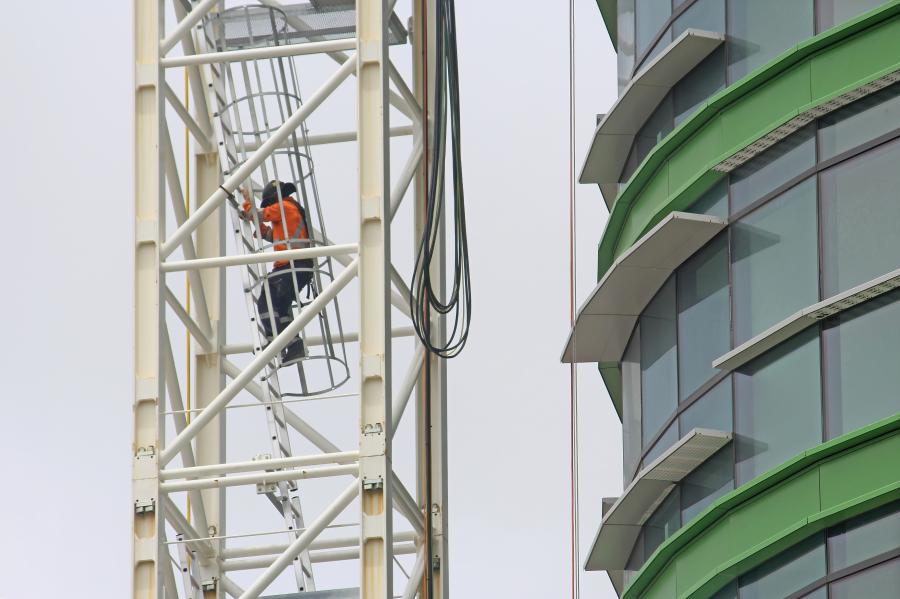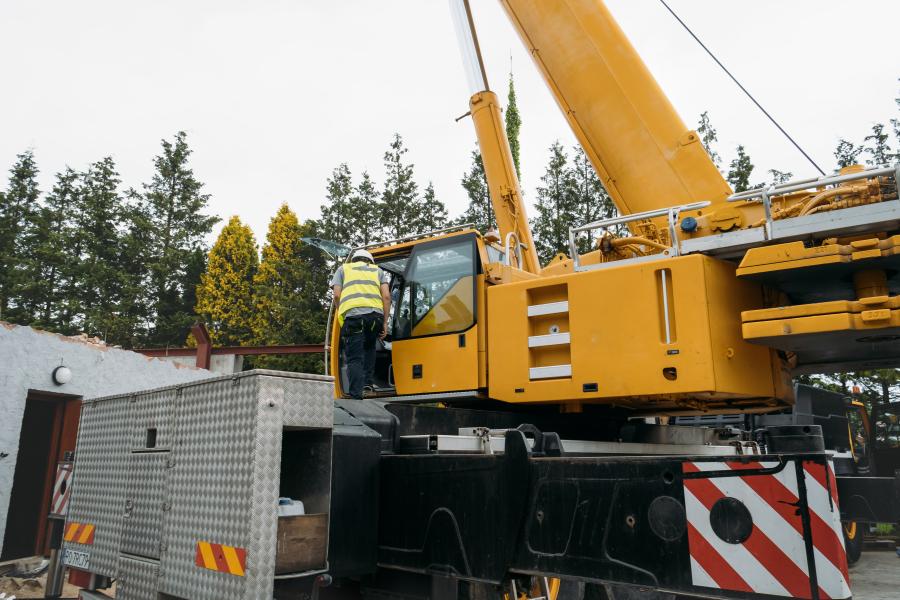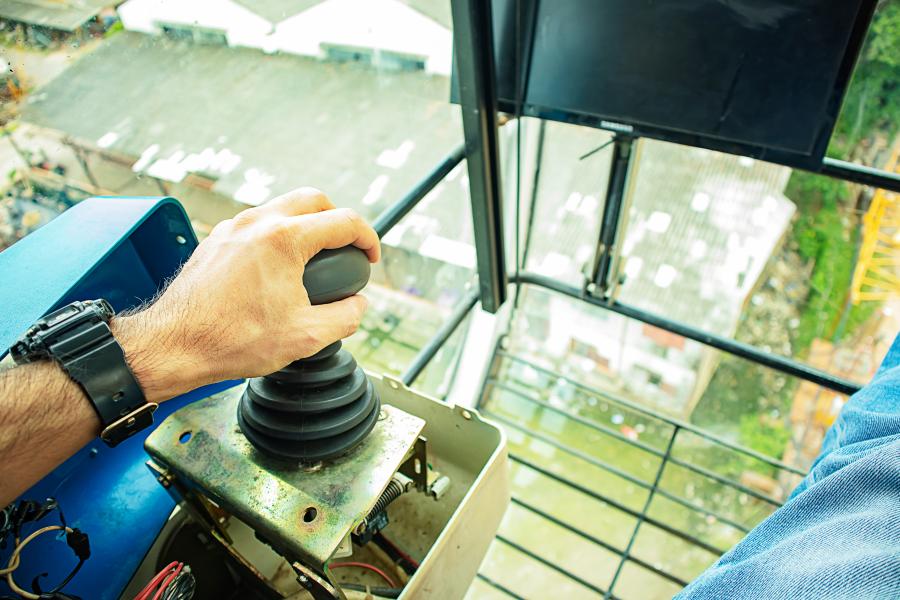Do mandatory breaks for tower crane operators make sense if they require workers to ascend and descend six times on a 10-hour shift?
A crane operator's comfort is crucial to a successful day at work. Discomfort to the point of tension is unhealthy, while relaxing to the point of drowsiness is a danger to the operator, crew and people on the ground. The notion of operator comfort during a long shift, whether that's high up in a tower crane cab or closer to the ground in a mobile rig, is gaining traction.
The National Safety Council (NSC), Itasca, Ill., reports that 69 percent of employees are tired on the job. This fatigue significantly increases the risk of workplace injuries and incidents, the nonprofit said.
Focused on high-risk industries where fatigue can have dire consequences, the report found that 100 percent of construction workers have at least one risk factor for fatigue. It also found that 46 percent of construction workers say they work during high-risk hours, such as at night or early morning.
"Worker fatigue is often an overlooked hazard on the construction site," found the NSC. "Fatigue, whether physical or mental, impairs a construction worker's ability to safely and effectively perform their job duties."
Fatigue also increases the risk of accidents and injuries, which can lead to unnecessary workers' compensation costs and can greatly reduce productivity on a project.
The safety organization suggests employers develop a fatigue management plan to help reduce the risks of fatigue-related accidents.
"Employers should make workers aware of the dangers of working while fatigued," it said. "Don't overload workers with too much or put unrealistic expectations for the completion of tasks because workers will feel compelled to push themselves too hard to complete them."
Employers also should monitor workers for signs of fatigue, ensure they're taking adequate breaks throughout the day and make sure workers drink plenty of fluids.
On hot days dehydration can contribute to fatigue, so employers need to be mindful how shift work, overnight work and extended hours affect employees.
Crane trainer Ron Overton said one major distraction to crane operators is being sedentary for long periods of time. Shifts can stretch from eight to 12 hours, so an operator has a tendency to relax if he or she is sitting in a particular spot for a long period of time. Stretching, movement of arms and legs and standing up for a while helps, said Overton.
"Some companies say the operator has to get out of the cab, stand on the car body and stretch in order to make the brain work before they can get back into the cab," he said.
He added since there is often downtime between lifts, operators are able to stop and walk around in between picks.
"Because they're actually sitting in a chair, they can only sit there for so long and then they feel like they have to get moving again," he said. "It causes the brain to reset and get back to an awareness of everything going on, as opposed to being kind of oblivious to the situation."
Eliminating Work Stoppages
The Specialized Carriers & Rigging Association (SC&RA) fought hard several years ago to convince the Federal Motor Carriers Safety Administration (FMCSA) to exempt crane operators from rest-break rules.
In 2020, the association was successful, and the federal hours-of-service (HOS) exemption for certain mobile crane operators was renewed until 2025.
The 30-minute rest-break exemption applies to operators of cranes with a lifting capacity of more than 30 tons.
"Among the reasons for the exemption request was that the HOS rules create a challenge to find suitable parking when crane drivers go off duty for breaks," said training organization J.J. Keller, Neenah, Wis.
SC&RA said that the exemption affects approximately 65,000 of the 85,000 trained and certified mobile crane operators in the United States.
The FMCSA published final changes to its HOS regulations and made the rule effective September 2020.
"The changes reflect some of the sentiments of SC&RA both in formal comments submitted last fall, and in a private meeting between SC&RA leadership and Jim Mullen," then-acting FMCSA administrator said in early 2020.
The new rule allows more flexibility for the 30-minute rest-break rule by requiring a break after eight hours of consecutive driving. It allows the break to be satisfied by a driver using "on-duty, not-driving" status, rather than "off-duty" status, according to SC&RA.
The rule allows drivers to divide their required 10 hours off duty into two periods: an 8/2 split or a 7/3 split.
"Neither period would count against the driver's 14-hour driving window," the association said.
It modifies the adverse driving conditions exception by extending by two hours the maximum window during which driving is permitted.
The rule lengthens certain short-haul drivers' maximum on-duty period from 12 to 14 hours. It also extends the distance limit within which the driver may operate from 100 air mi. to 150 air mi.
SC&RA member specialized transportation and crane and rigging companies find themselves addressing HOS challenges that can affect public safety as well as impact operational efficiency.
"On average, crane operators spend only one to two hours of on-duty time each trip driving a crane to and from a job site," said the association. "However, operators have multiple periods of unscheduled breaks when they are basically ‘at rest' or ‘on break.'"
During that time, they're waiting for the scheduled lift, for the load to be rigged and for the load to arrive on the job site. They're also waiting on jobsite delays extending the time on site, and then driving the roadways and dealing with traffic delays when returning to the yard.
Plus, mechanical breakdowns can happen, requiring a service technician and downtime waiting on repair, as well as weather delays.
SC&RA said the five-year exemption applies to all qualifying OS/OW motor carriers and drivers operating mobile cranes with a rated lifting capacity of greater than 30 tons.
Breaking Versus Climbing
Bathroom breaks for tower-crane operators are not required on all construction sites, but one major city is considering changing that situation.
Operators in Philadelphia often stay in their crane cabs all day where they eat and use the facilities in the same small space.
The Philadelphia Inquirer reported that the city council is considering legislation that would require supervisors to give tower-crane operators breaks of at least 30 minutes every four hours. Supervisors also would have to allow operators to leave the crane for restroom breaks at any time.
While allowed, breaks are currently not required, and most operators stay in their crane for the majority of their shifts.
During breaks, supervisors would be allowed to assign another operator to continue working the crane, according to the bill, which was moved out of committee to be considered by the full council.
How the requirements would be enforced is the question, according to the Inquirer.
The local construction industry said requiring operators to climb up and down hundreds of steps multiple times per shift presents its own safety hazards. But Mark Squilla, the councilmember who helped introduce the legislation, said the bill came about from his visits to construction sites.
"I thought, ‘This sounds sort of draconian,'" Squilla said in an interview. "There's no way they should have to stay up there where they're eating and going to the bathroom."
He added that after talking with workers the situation "sounded like something from the industrial days."
Manny Citron, chief of staff in the Philadelphia Department of Labor, said during the hearing that the bill "will make straightforward and commonsense changes" to the section of the Philadelphia Code that regulates use and inspection of tower and mobile cranes.
"This administration believes that it is in the interest of safety to the operator, their coworkers on the job, and also the public at large that workers operating critical machinery such as tower cranes should have regular access to breaks," Citron said. "Additionally, we believe that all employees should have reasonable access to sanitary facilities."
The Inquirer reported that Vaughan Buckley, chief executive officer of Volumetric Building Cos., said the association is "in full support of anything that enhances worker safety."
Speaking on behalf of the Building Industry Association of Philadelphia, he said the group objects to the bill's language requiring, instead of allowing, breaks.
On a 320-ft. tower crane, operators could have to climb as many as 500 steps to go up and another 500 to get down, Buckley said. At minimum, the legislation "would require them to ascend and descend six times on a 10-hour shift," he said.
This, he continued represents a combined ascent and descent of 1,800 ft. and nearly 3,000 rungs of a ladder.
"The idea that such a requirement is an enhancement to operator safety is really challenged by the facts."
Requiring operators to ascend and descend more often "exposes them to physical stressors" that could violate national safety protocols, Buckley said.
He added it also could endanger workers forced to leave their cranes in inclement weather. The requirement also "exposes the operators and the owners to a terrible choice," he said. "They can either follow the law, or they can enhance operator safety. In some cases, it will not be possible to do both."
Meantime, Councilman Squilla will continue his conversations with the building industry. He said if having workers go up and down several times becomes a problem, the city can revisit the requirements.
"I think we have an opportunity to help crane operators," he said. CQ
This story also appears on Crane Equipment Guide.
Lucy Perry
Lucy Perry has 30 years of experience covering the U.S. construction industry. She has served as Editor of paving and lifting magazines, and has created content for many national and international construction trade publications. A native of Baton Rouge, Louisiana, she has a Journalism degree from Louisiana State University, and is an avid fan of all LSU sports. She resides in Kansas City, Missouri, with her husband, who has turned her into a major fan of the NFL Kansas City Chiefs. When she's not chasing after Lucy, their dachshund, Lucy likes to create mixed-media art.
Read more from Lucy Perry here.
Today's top stories


















